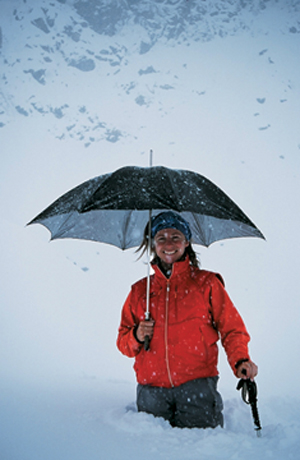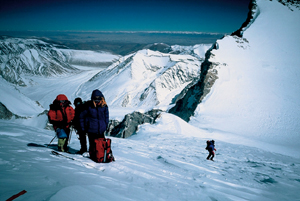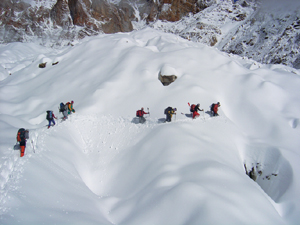


Kamet, First French Team
In the Himalayas massif, numerous summits and slopes are still opening up to discovery. Far from the madding crowd, a French team is opening a route across the eastern slope of the Kamet. A relaxed atmosphere for an incredibly beautiful trail.
TEXT & PHOTOS : Ludovic Challeat
To attempt the first French climb of the south-east face of the Kamet, a team of nine alpinists led by two French high mountain guides, Ludovic Challéat and Jean Annequin, set off for Delhi in September 2005. The highest point of the central Garhwal and the third highest Indian summit after the Kangchenjunga and the Nanda Devi, the Kamet gets its name from Kang-Med - a flamboyant glacier in Tibet - as it captures the first and last rays of sun. It is situated close to the Tibetan border, separated from its neighbour the Abi Gamin (7,355 metres) by the Meade Col (7,138 metres). This giant obelisk has three steep slopes: the eastern face rises 1,800 metres above the eastern glacier, the southern face (virgin) is 2,100 metres high and overhangs the left hand branch of the western glacier of the Kamet, the north-west face stretching between Abi Gamin and the Kamet. The first climb dates back to 1931; an expedition led by Franck Smythe set up base camp at an altitude of 4,300 metres and reached the summit via the Meade Col. Members of the team included one Eric Shipton. Of particular note is the fact that one of the participants uses skis for the ascent as well as the descent between 6,700 and 7,100 metres and skies from 6,300 metres as far as base camp… The Kamet is still seldom climbed and to date there have been very few ascents performed by westerners. There are still some firsts to be achieved on this high summit… A logical large scale itinerary (ice and mixed) can be performed on the 2,000 metre high south face. The buttress bordering the right hand side of the southern face, with its easier access, is also an objective of a similar nature. Maximum snowfall After Delhi, a polluted, noisy mega-city, the road leads us to Rishikesh, Joshimath and then Gamsali at an altitude of 3,300 metres, and the departure town to make our approach. Four days later, we reach Lake Vasudhara (4,700m) at the end of the path. From there the itinerary follows the stony glacier of the Kamet, which involves a two day climb to reach base camp at an altitude of 5,300 metres. Barely have we arrived when we are taken by surprise by three days of bad weather with a total of over two metres of snow. The mess tent explodes under the weight of the snow and some tents are seriously damaged by the wind from the avalanches which hurtle down the steep slopes in front of us. Suffice to say that the porters refuse to climb in these conditions (and they’re quite right!). We make a return trip to recuperate certain indispensable loads, returning to base camp at night, chilled to the bone and starving after a day’s trekking through mid-thigh deep snow… Following this there is a change of tempo: a spell of fine weather set to last until the end of the expedition! To get to the suspended plateau of camp 1 at 6,000 metres, the itinerary follows a steep couloir bordered by red granite buttresses. A last glacial cross cliff in the form of a gully enables you to get onto the plateau and then camp 1 at 6,100 metres. Our bags are heavy, and the bad weather has made us lose some precious days. We decide to continue our ascent without going back down to base camp prior to our attempt at the summit. Two days are then required to kit out the itinerary with fixed ropes enabling us to reach camp 2 at an altitude of 6,500 metres. This is the most technical part of the adventure: via a bold trail between rock ledges, gullies and mixed sections, we reach the final snowy slope bordered by an immense serac. A unique panoramic viewpoint awaits us with an extraordinary atmosphere reminiscent of a big face in the Alps! It takes a day to acclimatise followed by a rest day and then we climb the fissured glacier from the Abi Gamin to get to the Meade Col at 7,138 metres; the site of the final camp. The course is less technical but you can feel the effects of the altitude. Tomorrow will be the day of the summit…
Read the rest of the article in the Mountain Report magazine - Where to find ?


